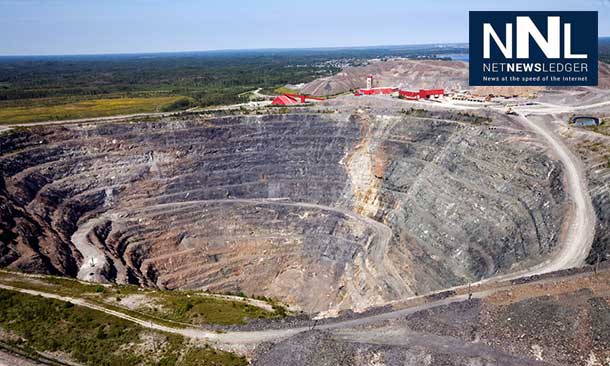Goldcorp Gold Production Up 11% in 2013
TORONTO – Mining – GOLDCORP INC. (TSX: G, NYSE: GG) has announced gold production and preliminary cash costs for 2013, and provided production and cash cost guidance for 2014 and the five-year period ending 2018.
Highlights
- Record gold production of 767,700 ounces in the fourth quarter, resulting in 2013 gold production of 2.67 million ounces, an increase of 11% over 2012.
- Forecast 2014 gold production to grow approximately 13-18%, to between 3.0 and 3.15 million ounces.
- 2014 all-in sustaining costs1 expected to decrease to between $950 and $1,000 per ounce.
- Gold production forecast to increase by approximately 50% over the next two years.
- Forecast reduction in all-in sustaining costs of 15-20% over the next two years.
- New life of mine plan for Peñasquito completed; updated NI 43-101 technical report filed today.
- Monthly dividend of $0.05 per share declared on January 6, 2014.
Goldcorp’s year-end financial statements are scheduled to be released on February 13, 2014. The final calculation of capital and operating costs has not yet been completed, but all-in sustaining costs for the fourth quarter and 2013 are expected to be approximately $885 and $1,065 per ounce of gold, respectively. On a by-product and co-product basis, costs are expected to be approximately $560 per ounce of gold and $710 per ounce of gold respectively in 2013.
“A continued, consistent focus on execution led to the achievement of Goldcorp’s 2013 guidance, including gold production and all-in sustaining costs,” said Chuck Jeannes, Goldcorp President and Chief Executive Officer. “Every Goldcorp-operated mine either met or exceeded 2013 production guidance with the exception of Los Filos, where record floods last summer temporarily halted production. Just as importantly, our successful cost reduction efforts in the face of lower gold prices resulted in key efficiency and productivity gains while keeping our growth profile intact. We successfully achieved our cost guidance despite significantly lower realized metals prices.
“Led by our flagship Peñasquito and Red Lake operations, our portfolio of low-cost mines will provide the operating cash flows to finance the completion of construction and start-up of our two newest mines, Cerro Negro and Éléonore. As we approach first gold production at these assets, capital spending will decrease significantly. Another year of forecast double-digit production growth in 2014, along with decreasing costs and decreasing capital expenditures positions Goldcorp for margin expansion and growing cash flow this year. Beyond 2014, continued forecast production growth, decreasing costs and significantly lower capital spending will position Goldcorp for a prolonged period of significant free cash flow generation. We remain committed to our gold-focused strategy and our mission to be the best gold company in the world.”
2014 Guidance
Goldcorp expects to produce between 3.0 and 3.15 million ounces of gold in 2014. Higher gold production will be driven by increasing grades at Peñasquito as mining progresses deeper into the Peñasco pit, and by the continued ramp-up at Pueblo Viejo. Expected mid-year initial gold production from Cerro Negro in Argentina and from Éléonore in Quebec in the fourth quarter also contribute to 2014 production growth. The timing of the ramp-up of production at Cerro Negro and Éléonore is expected to result in significantly higher gold production in the second half of 2014 compared to the first half of the year.
For 2014, the Company estimates that all-in sustaining costs will decrease to between $950 and $1,000 per ounce, compared to approximately $1,065 per ounce in 2013. Decreasing costs are expected to be driven by increasing grades and by-product production at Peñasquito, lower costs at Pueblo Viejo, low-cost production from Cerro Negro and Goldcorp’s continued overall focus on cost efficiencies through the Operating for Excellence program.
Silver production is expected to show very strong growth with 2014 production forecast at between 34 and 36 million ounces (including approximately 22 to 25 million ounces at Peñasquito). Zinc production is expected to be between 315 and 325 million pounds and lead production is forecast between 135 and 145 million pounds. Copper production is forecast between 88 and 93 million pounds. On a gold equivalent basis2, Company-wide 2014 production is expected to total between 4.05 million ounces and 4.25 million ounces.
Price and cost assumptions used to forecast total cash costs and gold equivalent calculation for 2014 include: $1,200per ounce for gold; by-product metals prices of $20.00 per ounce silver; $3.00 per pound copper; $0.90 per pound zinc; $1.00 per pound lead; an oil price of $100 per barrel; and the Canadian dollar and Mexican peso at $1.05 and$12.50 respectively to the US dollar. The Company continues to evaluate opportunities to contain input costs and minimize foreign exchange risk through the hedging of both fuel and currencies.
Mine-by-mine actual 2013 gold production and forecast 2014 gold production ranges are as follows:
| Mine | 2013 Production | 2014 Forecast |
| Peñasquito | 404,000 | 530,000 – 560,000 |
| Red Lake | 493,000 | 440,000 – 480,000 |
| Pueblo Viejo (40.0%) | 324,000 | 405,000 – 420,000 |
| Los Filos | 332,000 | 330,000 – 345,000 |
| Porcupine | 292,000 | 290,000 – 305,000 |
| Musselwhite | 255,000 | 230,000 – 240,000 |
| Marlin | 202,000 | 175,000 – 185,000 |
| Cerro Negro | 0 | 130,000 – 180,000 |
| Alumbrera (37.5%) | 118,000 | 125,000 – 130,000 |
| El Sauzal | 81,000 | 100,000 – 105,000 |
| Marigold (66.7%) | 108,000 | 95,000 – 100,000 |
| Wharf | 56,000 | 60,000 – 65,000 |
| Éléonore | 0 | 40,000 – 60,000 |
| Total | 2,665,000 | 3,000,000 – 3,150,000* |
*Mine-by-mine ranges reflect expectations at individual mines, but do not add up to corporate-wide guidance range total.
Canada
At Red Lake, 2014 gold production is expected to be stable at between 440,000 and 480,000 ounces. Production will be driven by mining of the High Grade Zone in addition to first production from the recently-discovered NXT Zone. Initiatives from the Company’s Operating for Excellence program, including zone mining and ramp optimization, are expected to contribute to lower costs and additional productivity gains. Exploration will continue to focus on the High Grade Zone at depth, the NXT zone up-plunge and testing the gap between the NXT and HGZ for new zones. A key focus of mine planning in 2014 will be on the continued integration of Cochenour, which is expected to reach initial production from the 5320 level in the fourth quarter of 2014. Construction of the five-kilometre haulage drift connecting the Cochenour shaft with the Red Lake mine on the 5100 level advanced to 86% complete at the end of 2013. With expected completion by the end of the first quarter of 2014, the critical path is now completion of the secondary egress and ventilation, expected in the fourth quarter of 2014. Total initial capital is expected to be $496 million, or approximately $44 million less than the original estimate, due primarily to a revised development plan that accelerates initial gold production by approximately six months, with approximately $125 million to be spent in 2014. Following ramp-up to full production, life-of-mine gold production from Cochenour is expected to be between 225,000 and 250,000 ounces per year, supplanting declining production from the existing Red Lake mine complex and maintaining overall production in excess of 500,000 ounces annually. At the end of 2013 there were two drill platforms in place and underground exploration diamond drilling of the Bruce Channel Deposit was in progress. During 2014, exploration drilling of the deposit will continue and further drilling from the haulage drift will continue to test new targets along the haulage drift.

At Porcupine in Ontario, 2014 gold production is expected to be between 290,000 and 305,000 ounces at lower forecast all-in costs, driven by increased production from the VAZ Zone and first gold from the Hollinger open pit, which is expected to contribute approximately 29,000 ounces. The Hoyle Pond Deep project continued to advance to access both depth extensions of current ore bodies and newly-discovered zones and to enhance flexibility and efficiencies throughout the operation. At Musselwhite in Ontario, gold production is expected to be between 230,000 and 240,000 ounces with lower forecast all-in costs. Exploration will continue to focus on defining the West Limb target potential.
At Éléonore in Quebec, construction continues on schedule with first gold production on track for the fourth quarter of 2014. Gold production is expected to be between 40,000 and 60,000 ounces in 2014. Overall surface construction progress has now reached 69%. The exploration ramp has now reached over 4,322 metres in length, corresponding to a depth of approximately 590 metres below surface and will be connected with the main 650 metre-mine level, creating a secondary egress with a complete ventilation circuit during the month of January. The production shaft has now reached a depth of 705 metres. Exploration drilling during 2014 will focus on expanding reserves and the 494 target closer to the surface. Capital expenditures at Éléonore are now expected to be between $1.8 billion and $1.9 billion, up from the previously-disclosed $1.75 billion, largely due to scope refinements and an assumption at the end of 2012 that excluded any cost inflation beyond 2013, with approximately $570 million to be spent in 2014. Forecast average life-of-mine gold production from Éléonore at full production is approximately 600,000 ounces per year.
Mexico
At Peñasquito, mining in the higher grade portion of the pit will continue throughout 2014 and, combined with an assumed throughput of 110,000 tonnes per day, production is expected to increase significantly to between 530,000 and 560,000 ounces. On a gold equivalent basis2, production is expected to total approximately 1.2 million to 1.25 million ounces. Production expectations over the balance of the five-year period assume throughput of 110,000 to 115,000 tonnes per day. During the fourth quarter of 2013, construction commenced on the Northern Well Field, which will increase overall water availability upon expected completion by the end of 2014.
The Company typically undertakes post-investment reviews of recently-commissioned operations after there is sufficient, meaningful operational data to support reconciliation to the feasibility study on which the investment decision was made. In conjunction with such a review, and in response to increased operating costs, higher Mexican taxes and lower assumed gold, silver, zinc and lead prices, the Company has prepared a new life-of-mine plan for Peñasquito, and as a result, today, has filed a National Instrument 43-101 updated technical report. As detailed in the technical report, the 2014 and five-year production profile has been positively affected by the revised mine plan. The report indicates increased cash flows over the life of the mine, supporting the current carrying value of the Peñasquito cash-generating unit. It also includes a reduction to the projected mine life from 19 years to 13 years because the final two phases of the previous ultimate pit and lower-grade mineralized material will not be mined or processed under current assumptions. As reflected in a Material Change Report filed today, a commensurate reduction in the Mineral Reserve estimates has resulted. The higher strip ratio pushbacks and lower-grade material requiring higher commodity prices to be economically processed has been re-classified as Mineral Resources.
In 2014, exploration at Peñasquito will continue to focus on defining the high-grade core of the copper-gold, sulphide-rich skarn mineralization located below and adjacent to current Mineral Reserves. Metallurgical test work on the mineralization is underway. In addition to exploration, Goldcorp is investigating the potential for producing a saleable copper concentrate at Peñasquito. An additional study is also underway to assess the viability of leaching a pyrite concentrate from the zinc flotation tailings. Successful implementation of one or both of these new process improvements has the potential to significantly improve the overall economics and add to the Mineral Reserves of Peñasquito through addition of another saleable product, and increasing gold and silver recoveries, respectively. Completion of the studies is expected by the end of 2014.
Negotiations are continuing between Minera Peñasquito and authorized representatives of the Cerro Gordo Ejido and the Company remains confident that a mutually beneficial settlement of the land claim will be reached.
Approximately 50 kilometres from Peñasquito, the Camino Rojo project continues to demonstrate the potential to become Goldcorp’s next major growth project, with drilling continuing to confirm the potential for a large-scale, sulphide mining operation. Previous five-year Company guidance had included production from a small oxide deposit near surface. These ounces have been removed from the five-year guidance until the Company completes a comprehensive pre-feasibility study. The pre-feasibility study is expected to commence in mid-2014 with expected completion by mid-2015.
Central and South America
At Pueblo Viejo, modifications to all four autoclaves have been completed and ramp-up to full capacity is on track for the first half of 2014. This is expected to drive production of between 405,000 and 420,000 gold ounces in 2014 (40% basis). Work will continue in 2014 on the enhancement of copper and silver recoveries and additional increases in autoclave availability. The new 215 MW power plant commenced commercial operations in the fourth quarter of 2013, providing the mine with a reliable, long-term power supply.
The Cerro Negro project in Santa Cruz, Argentina is progressing well and is on track to produce first gold at mid-year, with forecast gold production of between 130,000 and 180,000 ounces in 2014. Underground ramp development of the Eureka vein has advanced to 2,408 metres of the total 3,900 metres planned, while the Mariana Central ramp has progressed to 1,022 metres and the Mariana Norte ramp has completed 700 metres of development. The combined surface ore stockpile now contains an estimated 285,000 tonnes at an estimated grade of 10.53 grams per tonne gold and 206 grams per tonne silver. Along with Eureka, the Mariana Central vein will provide the initial production at Cerro Negro. Overall Engineering, Procurement and Construction Management (“EPCM”) activities reached 78% complete at the end of 2013. Total initial capital estimates remain unchanged at between $1.6 billion and $1.8 billion, with approximately $600 million to be spent in 2014. Exploration drilling has been suspended since the third quarter of 2013 following the uncertainty related to the Resource Tax imposed by the Provincial Government of Santa Cruz.
On October 22, 2013, the Environmental Assessment Commission of Atacama reinstated the environmental permit for the El Morro project, which had been suspended since April 27, 2012. Subsequently, on November 22, 2013 the Copiapo Court of Appeals granted an injunction suspending development of the El Morro project. This injunction was requested in constitutional actions filed by the Huascoaltino and Diaguita communities, which contend that recent consultations by the Chilean environmental authority was inconsistent with Convention ILO 169 standards. The injunction effectively suspends construction activity or development works until the Court has completed its review. Project activities during 2014 will continue to focus on gathering information to support permit applications for submission following the reinstatement of the environmental permit and optimization of the project economics including securing a long-term power supply. The Company remains committed to continued productive interaction and engagement with the community and authorities.
Financial Guidance
Approximately $620 million in cash at year-end, an undrawn $2 billion credit facility and continuing strong cash flows in 2014 are expected to provide the liquidity to fund Goldcorp’s growth profile. Capital expenditures for 2014 are forecast at between $2.3 billion and $2.5 billion, of which approximately 60% is allocated to projects and 40% to operations. Major project capital expenditures in 2014 include approximately $600 million at Cerro Negro, $570 million at Éléonore, $125 million at Cochenour, and $85 million at Camino Rojo.
Exploration expenditures in 2014 are expected to total approximately $190 million, of which approximately one third are expected to be expensed. Goldcorp’s primary focus will remain on the replacement of reserves mined throughout the year and on extending existing gold zones at each of its mines and projects. General and administrative expense is forecast at $185 million which excludes stock option expense estimated at $99 million for the year. Depreciation, depletion and amortization expense is expected to be approximately $385 per ounce of gold sold subject to the Company finalizing its year-end 2013 reserve and resource calculations. Driven by a higher tax rate for Pueblo Viejoas a result of the amended Special Lease Agreement and recently-enacted tax rate increases in Mexico, the Company expects its overall effective tax rate to increase to 41% in 2014.
Five-Year Forecast
New projects will make significant contributions to forecast five-year gold production growth, with first gold production expected from new projects as follows: Cerro Negro, mid-year 2014; Éléonore, fourth quarter 2014 and Cochenour, fourth quarter of 2014. Year-by-year gold production is forecast as follows:
| Year | Forecast Gold Production |
| 2014 | 3.0 to 3.15 million ounces |
| 2015 | 3.6 to 3.8 million ounces |
| 2016 | 3.7 to 4.0 million ounces |
| 2017 | 3.5 to 3.8 million ounces |
| 2018 | 3.5 to 3.8 million ounces |
Forecast average all-in sustaining cash costs are expected to decrease by 15-20% over the next two years, positioning the Company for continuing improved margins and free cash flow growth over the long term.
Goldcorp is one of the world’s fastest growing senior gold producers. Its low-cost gold production is located in safe jurisdictions in the Americas and remains 100% unhedged.
The Peñasquito technical report was prepared by Guillermo Pareja, P.Geo., Manager Resource Evaluation, Goldcorp and Maryse Belanger, P.Geo., Senior Vice President, Technical Services, Goldcorp, both of whom are considered “Qualified Persons” for the purposes of National Instrument 43-101 – Standards for Disclosure of Mineral Projects (“NI 43-101”). The scientific and technical information concerning Goldcorp’s mineral properties contained herein is based upon information prepared by or under the supervision of Maryse Belanger, Senior Vice-President, Technical Services of Goldcorp who is a “qualified person” within the meaning of National Instrument 43-101.
- The Company has included non-GAAP performance measures – total cash cost, by-product and co-product per gold ounce and all-in sustaining cash cost per gold ounce, throughout this document. The Company reports both of these measures on a sales basis.Total cash cost per gold ounce and all-in sustaining cash cost per gold in the gold mining industry is a common performance measure but does not have any standardized meaning, and is a non-GAAP measure. The Company follows the recommendations of the Gold Institute Production Cost Standard. The Gold Institute, which ceased operations in 2002, was a non-regulatory body and represented a global group of suppliers of gold and gold products. The production cost standard developed by the Gold Institute remains the generally accepted standard of reporting cash costs of production by gold mining companies. All-in sustaining cash costs include by-product cash costs, sustaining capital, corporate general & administrative expenses and exploration expense.
The Company uses total cash costs, by product and co-product, per gold ounce, to monitor its operating performance internally, including operating cash costs, as well as in its assessment of potential development projects and acquisition targets. The Company believes these measures provide investors and analysts with useful information about the Company’s underlying cash costs of operations and the impact of by-product credits on the Company’s cost structure and is a relevant metric used to understand the Company’s operating profitability and ability to generate cash flow. Accordingly, they are intended to provide additional information and should not be considered in isolation or as a substitute for measures of performance prepared in accordance with GAAP.
Total cash costs on a by-product basis are calculated by deducting Goldcorp’s share of by-product silver, copper, lead and zinc sales revenues from Goldcorp’s share of production costs. On a by-product basis, cash costs for 2014 are forecast to be between $550 per ounce and $600 per ounce.
- Total cash costs on a co-product basis are calculated by allocating Goldcorp’s share of production costs to each co-product based on the ratio of actual sales volumes multiplied by budget metal prices. On a co-product basis, cash costs for 2014 are forecast to be between $650 per ounce and $700 per ounce. Gold equivalent ounces are calculated using the following assumptions: $1,200 per ounce for gold; by-product metal prices of $20 per ounce silver; $3.00 per pound copper; $0.90 per pound zinc; and $1.00 per pound lead. By-product metals are converted to gold equivalent ounces by multiplying by-product metal production with the associated by-product metal price and dividing it with the gold price.







